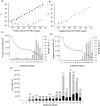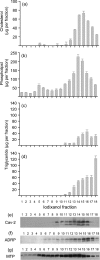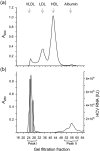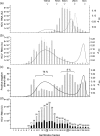Characterization of hepatitis C RNA-containing particles from human liver by density and size
- PMID: 18796720
- PMCID: PMC2557069
- DOI: 10.1099/vir.0.2008/000083-0
Characterization of hepatitis C RNA-containing particles from human liver by density and size
Abstract
Hepatitis C virus (HCV) particles found in vivo are heterogeneous in density and size, but their detailed characterization has been restricted by the low titre of HCV in human serum. Previously, our group has found that HCV circulates in blood in association with very-low-density lipoprotein (VLDL). Our aim in this study was to characterize HCV RNA-containing membranes and particles in human liver by both density and size and to identify the subcellular compartment(s) where the association with VLDL occurs. HCV was purified by density using iodixanol gradients and by size using gel filtration. Both positive-strand HCV RNA (present in virus particles) and negative-strand HCV RNA (an intermediate in virus replication) were found with densities below 1.08 g ml(-1). Viral structural and non-structural proteins, host proteins ApoB, ApoE and caveolin-2, as well as cholesterol, triglyceride and phospholipids were also detected in these low density fractions. After fractionation by size with Superose gel filtration, HCV RNA and viral proteins co-fractionated with endoplasmic reticulum proteins and VLDL. Fractionation on Toyopearl, which separates particles with diameters up to 200 nm, showed that 78 % of HCV RNA from liver was >100 nm in size, with a positive-/negative-strand ratio of 6 : 1. Also, 8 % of HCV RNA was found in particles with diameters between 40 nm and 70 nm and a positive-/negative-strand ratio of 45 : 1. This HCV was associated with ApoB, ApoE and viral glycoprotein E2, similar to viral particles circulating in serum. Our results indicate that the association between HCV and VLDL occurs in the liver.
Figures






Similar articles
-
Association between hepatitis C virus and very-low-density lipoprotein (VLDL)/LDL analyzed in iodixanol density gradients.J Virol. 2006 Mar;80(5):2418-28. doi: 10.1128/JVI.80.5.2418-2428.2006. J Virol. 2006. PMID: 16474148 Free PMC article.
-
Characterization of low- and very-low-density hepatitis C virus RNA-containing particles.J Virol. 2002 Jul;76(14):6919-28. doi: 10.1128/jvi.76.14.6919-6928.2002. J Virol. 2002. PMID: 12072493 Free PMC article.
-
Intravascular transfer contributes to postprandial increase in numbers of very-low-density hepatitis C virus particles.Gastroenterology. 2010 Nov;139(5):1774-83, 1783.e1-6. doi: 10.1053/j.gastro.2010.07.047. Epub 2010 Aug 2. Gastroenterology. 2010. PMID: 20682323
-
Hepatitis C virus: a new class of virus associated with particles derived from very low-density lipoproteins.Arterioscler Thromb Vasc Biol. 2012 May;32(5):1099-103. doi: 10.1161/ATVBAHA.111.241448. Arterioscler Thromb Vasc Biol. 2012. PMID: 22517369 Free PMC article. Review.
-
[Measurement of strand-specific hepatic HCV-RNA quantities of patients with hepatitis C virus infection].Nihon Rinsho. 2004 Jul;62 Suppl 7(Pt 1):417-21. Nihon Rinsho. 2004. PMID: 15359834 Review. Japanese. No abstract available.
Cited by
-
Apolipoprotein E, but Not Apolipoprotein B, Is Essential for Efficient Cell-to-Cell Transmission of Hepatitis C Virus.J Virol. 2015 Oct;89(19):9962-73. doi: 10.1128/JVI.00577-15. Epub 2015 Jul 22. J Virol. 2015. PMID: 26202245 Free PMC article.
-
Hepatitis C virus, cholesterol and lipoproteins--impact for the viral life cycle and pathogenesis of liver disease.Viruses. 2013 May 23;5(5):1292-324. doi: 10.3390/v5051292. Viruses. 2013. PMID: 23698400 Free PMC article. Review.
-
Ultrastructural and biochemical basis for hepatitis C virus morphogenesis.Virus Genes. 2017 Apr;53(2):151-164. doi: 10.1007/s11262-017-1426-2. Epub 2017 Feb 23. Virus Genes. 2017. PMID: 28233195 Review.
-
Hepatitis C virus: assembly and release of virus particles.J Biol Chem. 2010 Jul 23;285(30):22733-9. doi: 10.1074/jbc.R110.133017. Epub 2010 May 10. J Biol Chem. 2010. PMID: 20457608 Free PMC article. Review.
-
Hepatitis C virus relies on lipoproteins for its life cycle.World J Gastroenterol. 2016 Feb 14;22(6):1953-65. doi: 10.3748/wjg.v22.i6.1953. World J Gastroenterol. 2016. PMID: 26877603 Free PMC article. Review.
References
-
- Aizaki, H., Lee, K. J., Sung, V. M. H., Ishiko, H. & Lai, M. M. C. (2004). Characterization of the hepatitis C virus RNA replication complex associated with lipid rafts. Virology 324, 450–461. - PubMed
-
- Anonymous (2002). Gel filtration. Principles and Methods. Uppsala, Sweden: Amersham Biosciences.
Publication types
MeSH terms
Substances
Grants and funding
LinkOut - more resources
Full Text Sources
Other Literature Sources
Miscellaneous

